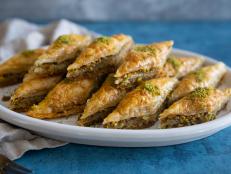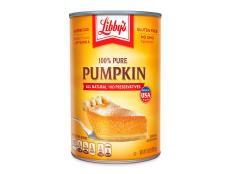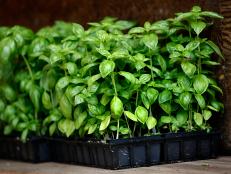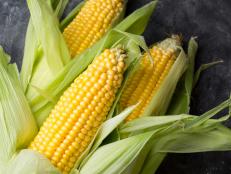"The Sacred Mushroom" — Everything You Need to Know About Morels

Thinkstock, Thinkstock
There are some ingredients that just scream luxury. Think of these ingredients as examples: caviar, lobster, truffles and Champagne. While we may know small bits of information on these products, if pressed for more info, we might struggle to give a detailed description of what they are, where they come from and what makes them so special (and so expensive).
This new feature will put on a spotlight on some of my favorite luxury ingredients. But I hope that when you read these articles, you will be inspired to seek out the best of the best and discover why your favorite Food Network chefs love them so much.
Everyone has a list of their own favorite ingredients, but there is one item that I know will bring a teary look of appreciation to just about every chef I encounter, and that is the morel mushroom. So much so that when I reached out to Iron Chef Alex Guarnaschelli for her opinion of the morel, she referred to it as the "sacred mushroom."
The morel, or morchella, is actually more related to the truffle than it is to other mushrooms and, like truffles, is the fruit of a fungus that sprouts in the moist soil of woods and forests. There are debates about the number of different types of morel, but the most common ones are black morels and yellow morels. They both have a stem and a conical body that is covered with pits and ridges like a honeycomb, which makes them instantly recognizable to anyone who spends time hunting for them. Morels are a spring mushroom that can usually be found between the months of March and May. Because of this very short growing period, they can be quite expensive when they are in season, costing upward of $20 per pound. They are definitely best served fresh, but can also be dried very easily, allowing them to be stored for use in the summer, fall and winter months.
Although they are strongly associated with French cuisine, morels are also very common in the United States, particularly in states such as Virginia, Kentucky and Michigan. They are often given local names such as Dry Land Fish or Hickory Chickens, which originate from the way that they look or the way that they are prepared.
There are now some decent kits available to enable you to grow your own morels at home. Morels are still quite hard to cultivate, however, and by far the majority are harvested wild by hunters during the spring growing season.
Mushroom hunters will can be very secretive when it comes to protecting the sites they find that offer up the most morels, but there are now smartphone apps where some of the more generous hunters will share the locations where they have been most successful. These are usually areas of moist soil in woods or forests, often under the stumps of trees that have fallen. Hunters are particularly keen to hear about forest fires, as these also provide ideal conditions for the growth of morels. As they say, it is an ill wind that blows nobody any good.
I have to agree with Iron Chef Guarnaschelli: When it comes to mushrooms, I would place morels at the top of the heap. They are terrifically versatile, are wonderful on their own and add great depth of earthy flavor to any dish that includes them. Even though morels are not a cheap option, because of their very short growing season, their arrival in stores is a very special occasion, and I have even heard more than one chef call them "the herald of summer." The fact that they can be preserved so easily (I dry mine in the oven) means that they are available to use all year round, and both fresh and dried morels have their own unique characteristics that make them an essential in my kitchen.
Before you do anything else, please make sure that what you have in your hand is actually morels, as there is a variety of the mushroom known as the "false morel," which can be very toxic. Of course, if you have bought your morels from a reputable store or been gifted them by good source, this should not be a problem. But it always pays to be careful.
Once you are sure you have the genuine article, I like to follow the advice of my favorite chefs and treat the fresh morels with lots of respect. As Iron Chef Geoffrey Zakarian puts it in what could be the opening line of a poem, "I like them very simple, slowly sweated in a bed of fresh shallots. A dash of good Madeira, a swirl of salted Irish butter and a gentle rain of fresh tarragon leaves."
"I clean them by soaking in cold water many times. If bugs are at all present, I add a splash of vinegar to the water. My favorite preparation is to sweat some minced shallots in butter; salt them generously. Add the morels and salt again. Resist the urge to stir or add anything and allow them to sweat on low heat for about 10 minutes. Then stir. Add a few splashes of dry vermouth (Noilly Prat preferred) and simmer over low heat until all the liquid has evaporated.
I never cook in any stock, because then they taste like stock. Transfer to a baking sheet and let cool.
Heat a large saute pan until hot. Add butter. When the butter melts and browns, add the morels and brown for a few minutes.
Add a squeeze of lemon. Pour any liquids or shallot bits into pan with the mushrooms.
I am not going to try to compete with the recipes of two of the best chefs on the planet, so let me just add that if you are using dried morels, you simply need to refresh them in water for about 20 minutes, or until the mushrooms are soft, before using them. Make sure to retain their soaking liquid, which is full of morel flavor and is wonderful added to a risotto, a sauce or a soup.
I'm now going to try to see if I can make it rain tarragon.






























































